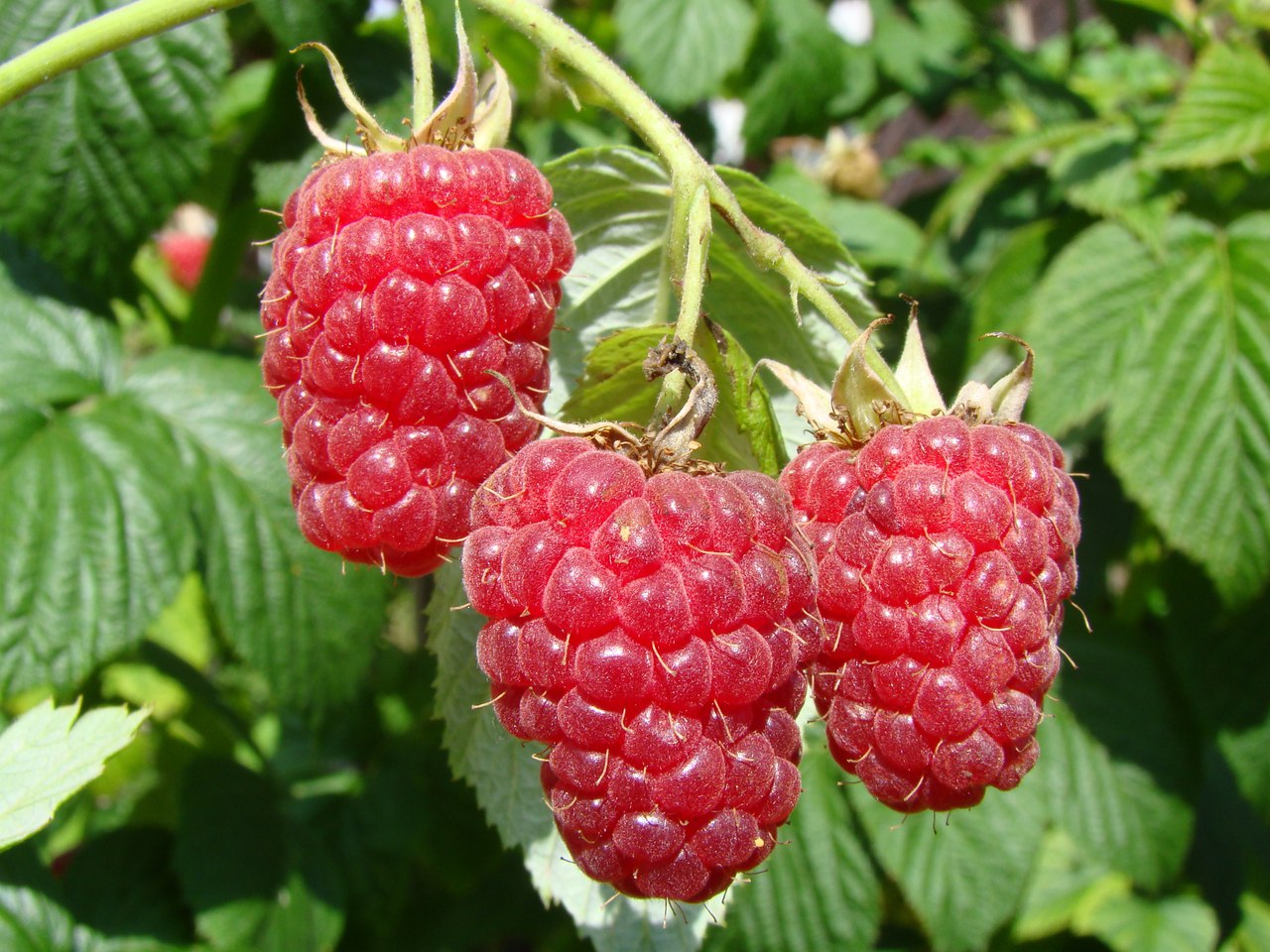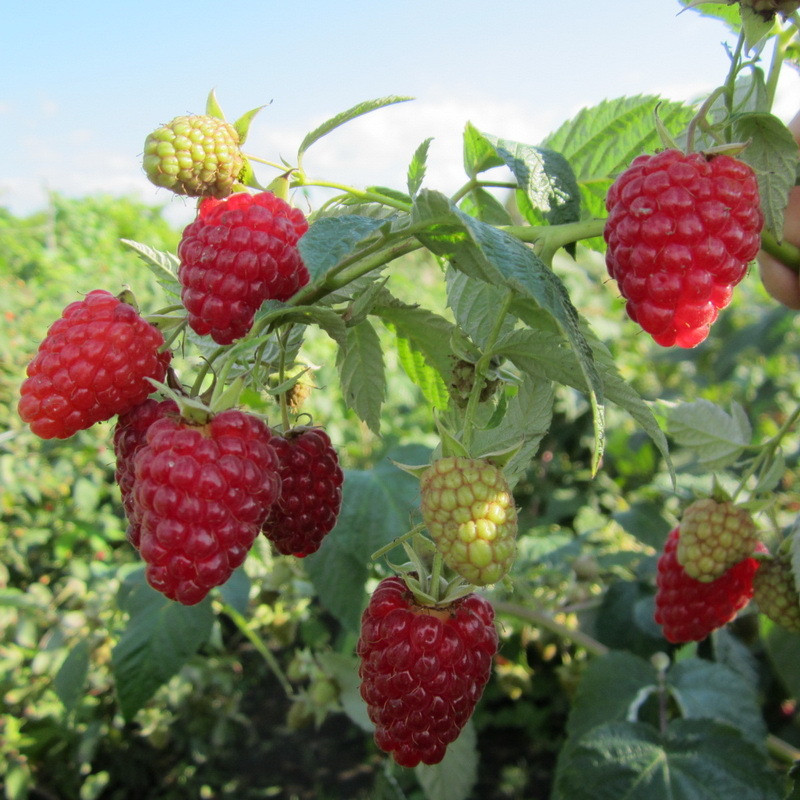Content:
According to the State Registers, Indian Summer raspberries are grown on an industrial scale in the Central, North-Western regions and in the Caucasus, which indicates the plant's ability to adapt in cool conditions.
Characteristics of the raspberry variety
This variety is derived from the other two - Kuzmin's News and Kostinbrodskaya, borrowing their best qualities. Description of raspberry Indian summer confirms this:
- an upright bush is weakly spreading and grows no more than one and a half meters, which makes it possible to form an extensive plantation on small acres;
- shoots are of medium thickness and covered with rigid, straight, large thorns;
- young stems can be recognized by their pink color and waxy bloom;
- the nature of shoot formation is average, but the branching is increased;
- greenish leaves on bushes are smoothly wrinkled and slightly curled;
- all lateral branches are densely dotted with truncated conical fruits;
- the color of the berries is bright red, and the taste is pleasant, truly raspberry;
- fruits do not lose their qualities during the rainy season and do not sour from an abundance of moisture;
- this variety is valued for its healing properties - ascorbic acid in fruits contains about 30 mg;
- a medium-sized berry weighs about 3-3.5 g, provides a yield of up to 1 kg per bush (or 37 centners per hectare) when harvested twice (in June and August).
Note! If you transfer the remontant bush to the mode of one harvest (i.e. cut out last year's shoots), then you can increase the yield and take 3 kg from each plant.
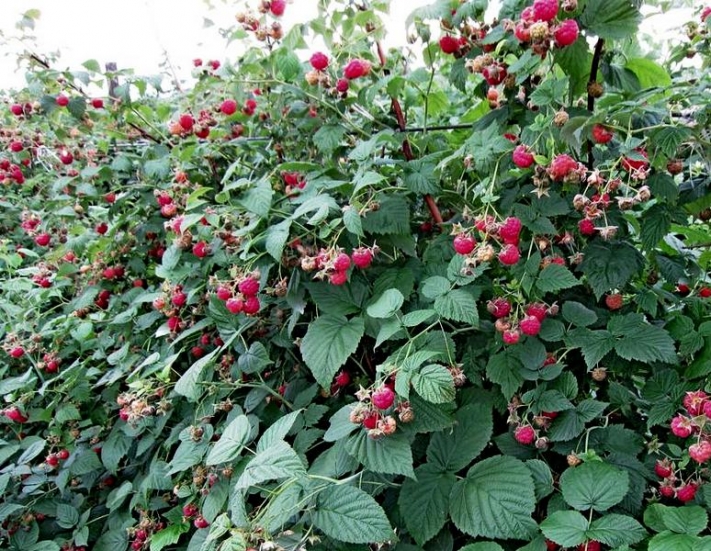
During the fruiting season
Indian summer is considered a universal variety, therefore it is actively used not only for fresh consumption - the fruits are good in conservation and freezing.
The main disadvantage is weak immunity against certain diseases. The variety is also annoyed by pests. But raspberries have good resistance to gray rot and curl.
As mentioned above, these plants feel comfortable in cool regions, but this does not mean that they will take root in areas with harsh winters, where temperatures are below -30 degrees. But where this variety is definitely not grown, so in the southern regions. Indian summer can hardly endure high temperatures and is dying from drought.
Care features
Crop care includes a whole range of agrotechnical measures. Only with their regular observance can one hope for a good harvest.
Site selection and preparation
Despite the fact that this variety does not tolerate hot weather, it is recommended to break the berry field in the southern zone of the garden plot, closer to the fence (near the house or near the outbuilding), in order to protect the bushes from drafts.
The height of groundwater should also be taken into account - underground streams should pass below one and a half meters from the soil surface. Otherwise, moisture will stagnate in the roots, and the plants will begin to ache.
Pits or trenches for seedlings are prepared in advance, trying to ensure that their width and depth are 0.5-0.6 m each. The bottom is covered with a nutritious "pillow" of compost, high peat and humus (at the rate of 3 buckets per 1 square meter of trench) ... Mineral water is also added here.
Planting seedlings
The berry can be planted in any season, but it is preferable to do this in early October. Before lowering the seedlings into the prepared grooves (pits), a little soil is poured over the fertilizer and the roots are evenly distributed over it.Having filled the space around the seedlings with earth, it is well tamped so that the roots are better fixed.
At the end of this procedure, up to 6 liters of water are applied under each bush. Using organic matter or mown grass, the land around the plants is mulched.
There are several options for planting raspberries Indian summer:
- distributing in a line with a distance of 1 m between bushes and 2 m between rows;
- according to the square method - one bush in each corner of the square, where the side of the rectangle is 1.5 m.
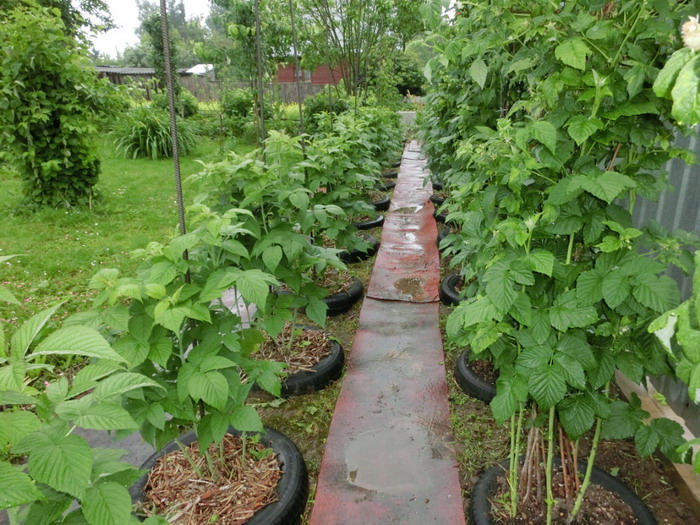
Landing option
Single planting of seedlings disbanded across the site is also allowed, but this is not always convenient.
Trimming
In the first year, when planting in autumn, the bushes are not cut off - on these shoots, in June of the next season, it will be possible to harvest. But in October of the second year, they will have to be removed.
Additional Information. Since the plant produces little growth, there is no particular need for thinning.
The frequency of pruning per year depends on the purpose of the raspberry. If there is a desire to collect 2 crops per summer, then the shoots of this season are not cut off before winter, but are left for fruiting next year. If the goal of the gardener is one, late, but more abundant harvest, then pruning of the bush is carried out every autumn.
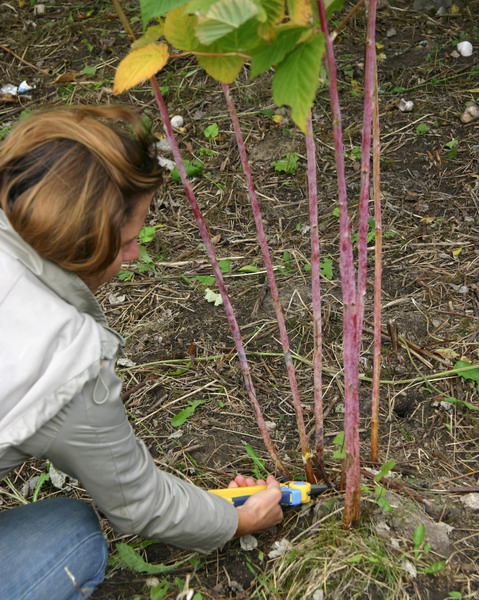
Pruning shoots
Note! When planting seedlings in the spring, the tops are slightly cut off on the shoots, without affecting the areas with buds. This will stimulate branching and affect yields.
Care advice
- Indian summer is sensitive to lack of moisture. To prevent the plant from dying, in dry weather, the soil should be moistened every day. One of the options for caring for the berry is drip irrigation;
- Regular weeding is required. Harmful insects often settle in this grass, and raspberries of this variety are susceptible to diseases;
- Periodic loosening of the soil is required, but this should be done carefully, given the fragility of the root system, located shallow from the surface.
If it is not possible to pay attention to the berry every day, such actions are recommended. A triple rate of water is poured under each bush, then the soil around the plants is covered with a thick layer of mulch. The soil retains moisture longer, and the weeds do not grow as actively.
Top dressing
Fruiting crops are quickly depleted and need additional feeding. The following fertilizers are applied under raspberries of this variety:
- once a month from April to June, they feed them with liquid manure (1 liter per bucket of water) or a solution of chicken droppings (1:20);
- organics are combined with mineral water - potassium sulfate (20 g), superphosphate (40 g) and nitrate (15 g);
- for autumn feeding, it is enough to use only potassium.
Important! With sulfuric acid fertilizer, the main thing is not to overdo it - it will harm the plant. Therefore, during autumn work, you must not use more than 30 g / 1 sq. M. berry.
Reproduction
Indian summer raspberries are easy to breed on the site without buying additional seedlings - just use root suckers. Work is carried out in the second half of May or June. Having found a young shoot (no more than 20 cm) near an adult bush, they rake the soil around it to get to the root. The offspring is carefully cut off and taken out of the ground, the roots of the parent plant are sprinkled with soil.
After making sure that the shoot roots are healthy (they should be white in color), the sprout is immediately planted in a permanent place, following all the actions described above with the seedlings. If everything is done correctly, then the shoot will grow very quickly and will harvest next season.
Diseases and pests
The Indian Summer variety is not resistant to pest infestations and is often subject to disease. To prevent the plants from dying, you need to be able to recognize the problem in time and quickly fix it.
The main diseases of the raspberry Indian summer
| Diseases, pests | Description | Measures |
| Sheet mosaic | Spots of dark and white color on the bushes, indeed, resembling mosaic ornaments | The disease is not treated, so you will have to completely remove the plant, capturing the neighboring bushes |
| Mottling purple | Young shoots are sick, covered with brown spots, which, growing rapidly, lead to wilting of the branches | Do sanitary pruning to preserve healthy stems. Spring spraying of plants with Hom and Bordeaux 1% liquid will help protect against disease |
| Powdery mildew | White bloom covers berries and leaves in warm, humid weather | Get rid of dew by spraying the bushes with Fundazol or Topaz |
| Crimson beetle | Insect larvae are harmful - they eat fruits | Berry trees are sprayed with Spark or manganese solution |
| Spider mite | The cobweb on the bush, as well as the eaten spots on the leaves (the mite feeds on their juice) will help to recognize the presence of the pest | Recommended to fight Fermitek or Fitovermo |
| Raspberry aphid | Prefers to settle on young shoots. The presence is indicated by twisted, rapidly fading leaves | Shoots inhabited by aphids are cut and burned. For prophylactic purposes, Karbofos is used in the spring. |
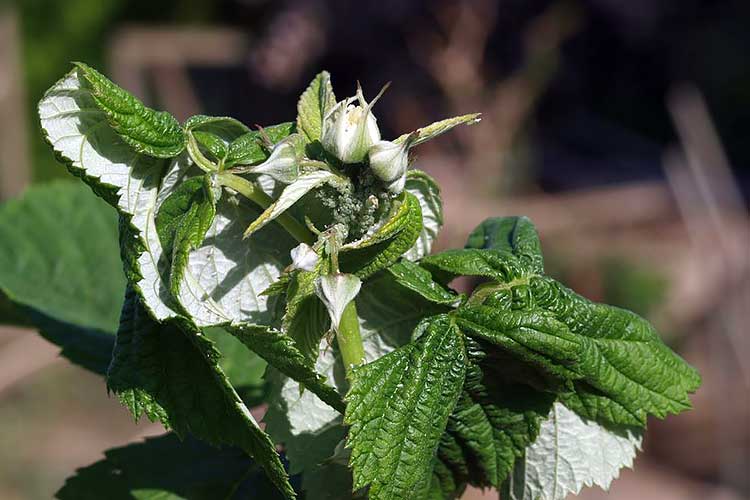
The first sign of aphids
Wintering
The variety, although resistant to cold weather, requires careful shelter for the winter. To begin with, you need abundant autumn watering - this will help the roots to survive the cold more easily.
If raspberries are grown exclusively as an annual, then all shoots are cut to the very root before frost. The ground around the bush and the posts left after pruning the branches are mulched with a large layer of straw, sawdust or peat.
With a 2-year-old culture, proceed as follows:
- part of the shoots is completely cut out, leaving only the strongest on the bush;
- the remaining branches are connected together and bent to the ground, fixing with hairpins or pegs;
- shoots are tightly covered with spruce branches.

Preparing for winter
If the winter is planned with little snow and cold, it is advisable to additionally wrap the branches with plastic wrap. To prevent the snow that has fallen on the site from being blown by the winds, it is recommended to install low fences along the raspberry tree.


